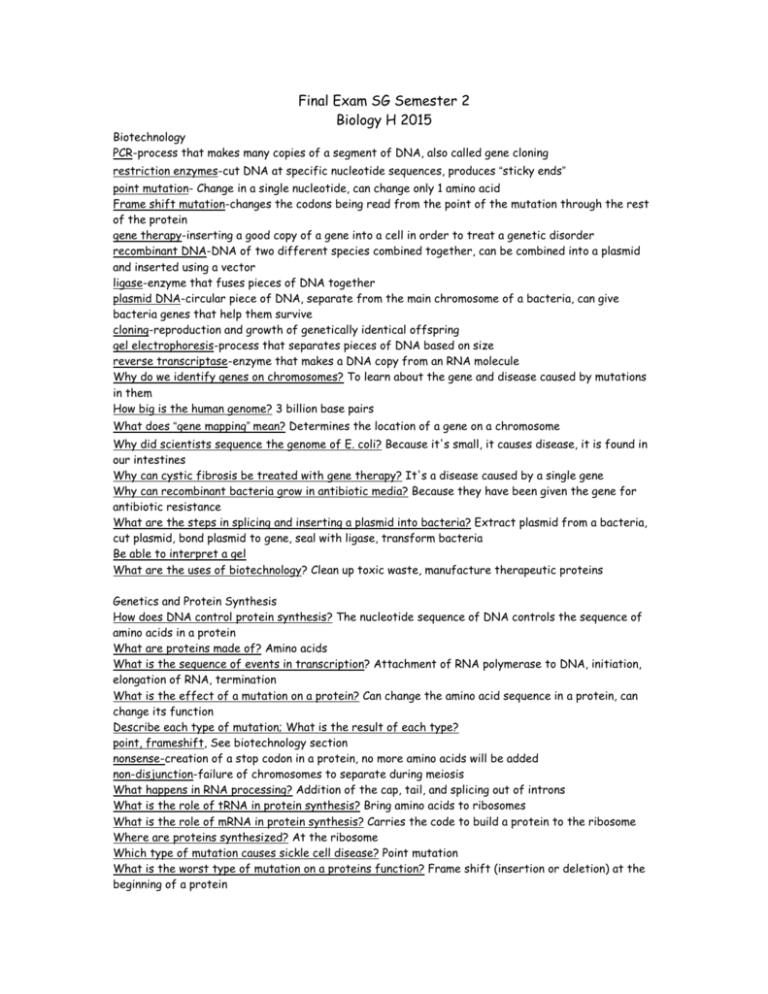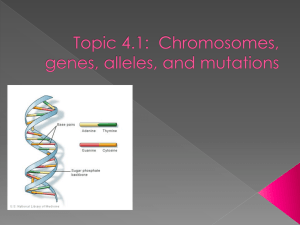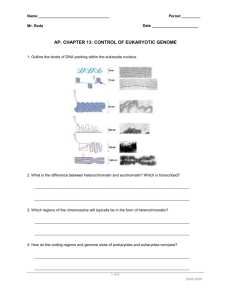Final Exam SG Semester 2 Biology H 2015 Biotechnology PCR
advertisement

Final Exam SG Semester 2 Biology H 2015 Biotechnology PCR-process that makes many copies of a segment of DNA, also called gene cloning restriction enzymes-cut DNA at specific nucleotide sequences, produces “sticky ends” point mutation- Change in a single nucleotide, can change only 1 amino acid Frame shift mutation-changes the codons being read from the point of the mutation through the rest of the protein gene therapy-inserting a good copy of a gene into a cell in order to treat a genetic disorder recombinant DNA-DNA of two different species combined together, can be combined into a plasmid and inserted using a vector ligase-enzyme that fuses pieces of DNA together plasmid DNA-circular piece of DNA, separate from the main chromosome of a bacteria, can give bacteria genes that help them survive cloning-reproduction and growth of genetically identical offspring gel electrophoresis-process that separates pieces of DNA based on size reverse transcriptase-enzyme that makes a DNA copy from an RNA molecule Why do we identify genes on chromosomes? To learn about the gene and disease caused by mutations in them How big is the human genome? 3 billion base pairs What does “gene mapping” mean? Determines the location of a gene on a chromosome Why did scientists sequence the genome of E. coli? Because it's small, it causes disease, it is found in our intestines Why can cystic fibrosis be treated with gene therapy? It's a disease caused by a single gene Why can recombinant bacteria grow in antibiotic media? Because they have been given the gene for antibiotic resistance What are the steps in splicing and inserting a plasmid into bacteria? Extract plasmid from a bacteria, cut plasmid, bond plasmid to gene, seal with ligase, transform bacteria Be able to interpret a gel What are the uses of biotechnology? Clean up toxic waste, manufacture therapeutic proteins Genetics and Protein Synthesis How does DNA control protein synthesis? The nucleotide sequence of DNA controls the sequence of amino acids in a protein What are proteins made of? Amino acids What is the sequence of events in transcription? Attachment of RNA polymerase to DNA, initiation, elongation of RNA, termination What is the effect of a mutation on a protein? Can change the amino acid sequence in a protein, can change its function Describe each type of mutation; What is the result of each type? point, frameshift, See biotechnology section nonsense-creation of a stop codon in a protein, no more amino acids will be added non-disjunction-failure of chromosomes to separate during meiosis What happens in RNA processing? Addition of the cap, tail, and splicing out of introns What is the role of tRNA in protein synthesis? Bring amino acids to ribosomes What is the role of mRNA in protein synthesis? Carries the code to build a protein to the ribosome Where are proteins synthesized? At the ribosome Which type of mutation causes sickle cell disease? Point mutation What is the worst type of mutation on a proteins function? Frame shift (insertion or deletion) at the beginning of a protein Genotype: type of alleles an organism has, determines the phenotype Probability rules of getting heads: 1/2, tails: 1/2, a boy: 1/2, two boys: 1/4 Dominant vs. recessive alleles/traits: dominant can hide a recessive trait, if you get 1 dominant allele you show the dominant trait Principle of segregation: homologous chromosomes and alleles separate during meiosis so each gamete ends up with one of each Types of gametes produced by: AABb, AaBb: AB, Ab, AB, Ab, aB, ab Monohybrid and dihybrid ideal ratios: Aa x Aa, AA x aa, AaBb x AaBb Sex-linkage, determination, inheritance—trait is a sex chromosome (most are on the X chromosome), Mom gives and X to all of her daughters and sons, dad gives an X to his daughters and a Y to his sons and determines the sex of the offspring Human blood type problems A x B, A x A, AB x O Polygenic inheritance and examples: trait controlled by more than 1 gene, eye color, skin color, usually a bell curve distribution in a population Be able to interpret a pedigree chart-- squares are males, circles are females, if they are colored in they have the trait Why are calico cats always female? They need to have 2X chromosomes to be heterozygous for color, 1 X is inactivated at random giving them patches of color Animal development and Internal Responses zygote-fertilized egg, formed by fusion of egg and sperm cleavage-early cell division without growth differentiation- cell starts to produce proteins that make it develop into a certain cell type blastula-hollow ball of cells produced by cleavage induction-chemical released by one cell type causes a change in another cell type notochord—becomes the backbones yolk—energy rich food for the embryo morphogenesis- formation of body structures determination-genes get turned off, beginning of becoming different metamorphosis-change in body form between juvenile and adults activation-causes the fertilized egg to begin dividing fertilization-fusion of egg and sperm depolarization-switching of charges in a neuron to carry an impulse Repolarization-restoration of resting potential in a neuron, has to happen before a neuron can carry another impulse antigens-proteins on the outside of cells that allow them to be identified antibodies-produced by B cells in response to antigens memory cells-remembers how to fight a specific invader, gives you immunity to a pathogen T cells-help B cells make antibodies B cells-make antibodies cytotoxic cells-kill your infected body cells to prevent pathogens from reproducing homeostasis-maintenance of internal body conditions placenta- brings nutrients to and waste products away from a fetus umbilical cord-connection between a fetus and the placenta # of chromosome in a gamete 1/2 as many as in a body cell Sequence of events in animal development: fertilization, growth, differentiation, morphogenesis What is the result of cleavage? the blastula What is the fate of each germ layer? Ectoderm-skin and nervous system, mesoderm-muscles and bones, endoderm-digestive system How do identical twins form? When an embryo splits into two babies What is the gene-equivalence hypothesis? All cells have the same genes What happens to genes during differentiation? Their ability to express protein becomes restricted How is a nerve impulse transmitted? Chemical and electrical changes across the cell membrane How are impulses transmitted between neurons? Across a synapse by neurotransmitters What is the direction an impulse travels in a neuron? from dendrite to axon What is “self vs. non-self” in our immune system? The ability of our immune systems to recognize our cells vs pathogen cells Give several examples of non-specific immunity. Skin, mucous membranes, macrophages, phytoalexins in plants, fever, antibacterial enzymes What is the cause of inflammation? Histamine Which type of immunity works against the most types of invaders? Non-specific immunity How do vaccines promote immunity? They allow your body to make antibodies against antigens without making you sick What are the effects of histamine? It makes capillaries swell up and get leaky, cause allergies Describe and give examples of both negative feedback and positive feedback systems. Negative feedback-brings you back toward normal, insulin and glucagon work together to maintain blood sugar levels , positive feedback brings you farther away from normal, child birth, blood clotting What is a target cell? The cell a signal can act on Why can cells respond differently to a hormone? Because they have different signal transduction pathways inside them What are the effects of insulin? Lower blood sugar levels Of glucagon? Raises blood sugar levels Evolution microevolution- change of allele frequency in a gene pool, can happen quickly macroevolution -can lead to speciation, takes a long time gene pool-all the alleles in a population variation-differences between members of a species species-group of organisms that can interbreed and produce fertile offspring homologies-structures that indicate common ancestry adaptive radiation-burst of microevolutionary activity that can lead to the formation of many species from a common ancestor in a relatively short period of time Be able to solve Hardy-Weinberg problems, know the assumptions: population is diploid and sexually reproducing, non-overlapping generations, random mating and union of gametes, large population, no mutation or migration; p + q =1, p2 + 2pq + q2 = 1 What is the unit of evolution? Population What is the relationship between Natural Selection and gene pools? It increases the frequency of alleles that increase fitness and decrease the frequency of those that decrease fitness What factors change gene pools? Natural selection, genetic drift, gene flow, mutation What are the characteristics of hybrid offspring? They are sterile What do homologies indicate? Common ancestry List the order of taxa from largest to smallest domain, kingdom, phylum, class, order, family, genus species Why do we use scientific names? Because common names can be different in different places Know the characteristics of each Kingdom: Monera: unicellular, auto and heterotrophic, prokaryotes, motile; Protista: uni and multicellular, auto and heterotrophic, motile and non-motile; Fungi: uni and multicellular, heterotrophic, non-motile; Plantae: autotrophic, multicellular, non-motile; Animalia: heterotrophic, multicellular, motile Why can classification of an organism change? Because additional information is learned Types of isolating mechanisms: geographic-live in the same habitat but don't meet so they can't mate; seasonal-timing of reproduction; mechanical-parts have to fit together to deliver the gametes; behavioral-mating rituals, if you don't know the dance you can't mate Ecology primary consumers- eat producers producers-convert light energy into chemical energy, base of every food chain secondary consumers-eat primary consumers decomposers-recycle the atoms food web-show the energy and feeding relationships between organisms food chain-one organism at each trophic level competitive exclusion: different species use different resources in a habitat to lesson competition niche: role of an organism, all the biotic and abiotic resources an organism needs parasitism- +/- relationship symbiosis-any relationship between organisms commensalism- +/0 relationship mutualism- +/+ relationship exponential growth- growth without limiting factors chaparral: our ecosystem, needs periodic fires photic zone: region of the ocean that gets light, photoautotrophs live here Aphotic zone: deep water, chemoautotrophs are the producers here abyssal zone: bottom floor of the ocean Which trophic level is most affected by toxins? the top level consumers Which elements get recycled? All of them What happens when you add carbon dioxide to water? the pH levels go down Why is the amount of carbon dioxide increasing in the atmosphere? Burning fossil fuels How have ecosystems been disturbed? Human consumption, use of chemicals, introduction of nonnative species What is the main dispersal agent? Humans What is the first life on bare rock? Mosses and lichens Primary vs secondary succession; what is the result? Primary is from bare rock, secondary is after a disturbance, result is climax community What are the characteristics of the best colonizer plants? Very tolerant of temperature and moisture levels What is the greenhouse effect? Greenhouse gasses trap the UV light causing an increase in temperature near the earths surface How do plants effect an ecosystem? They affect temperature and moisture levels by absorbing sunlight and releasing moisture through transpiration









